Scientific name Salicornia Rank Genus | ||
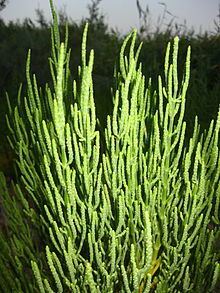 | ||
Similar Salicornia europaea, Suaeda, Chenopodiaceae, Cordgrass, Sarcocornia | ||
2012 yuma salicornia planting 5min 15 sec
Salicornia is a genus of succulent, halophyte (salt tolerant) flowering plants in the family Amaranthaceae that grow in salt marshes, on beaches, and among mangroves. Salicornia species are native to North America, Europe, South Africa, and South Asia. Common names for the genus include glasswort, pickleweed, and marsh samphire; these common names are also used for some species not in Salicornia. The main European species is often eaten, called marsh samphire in Britain, and the main North American species is occasionally sold in grocery stores or appears on restaurant menus, usually as 'sea beans' or samphire greens or sea asparagus .
Contents
- 2012 yuma salicornia planting 5min 15 sec
- Eattheweeds episode 74 glasswort salicornia samphire
- Description
- Distribution and habitat
- Ecology
- Phylogenetics
- Systematics
- Culinary
- Historical
- Contemporary
- Environmental uses
- References
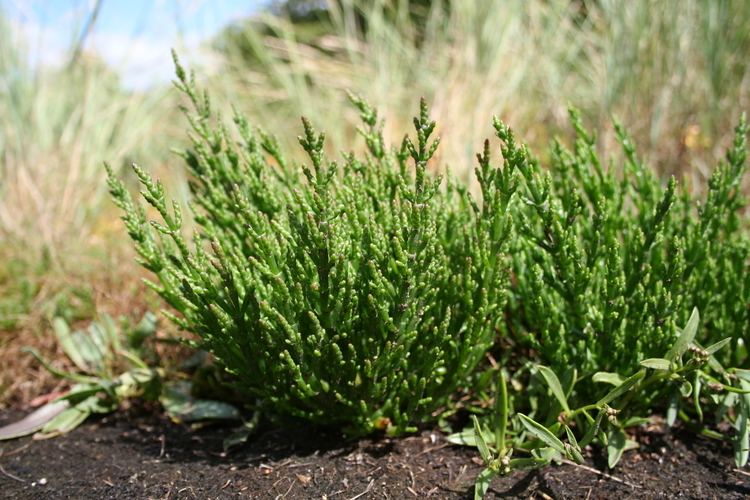
Eattheweeds episode 74 glasswort salicornia samphire
Description
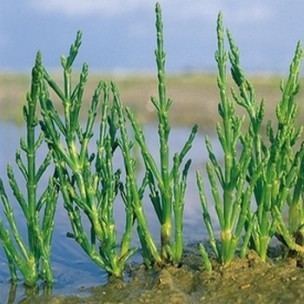
The Salicornia species are small annual herbs. They grow prostrate to erect, their simple or branched stems are succulent, glabrous, and apparently jointed. Older stems may be somewhat woody basally. The opposite leaves are fleshy, glabrous, sessile, basally connate and decurrent and enclosing the stem (thus forming the joints). The leaf blades are reduced to small collar-like scales with narrow scarious margin. Many species are green, but their foliage turns red in autumn.
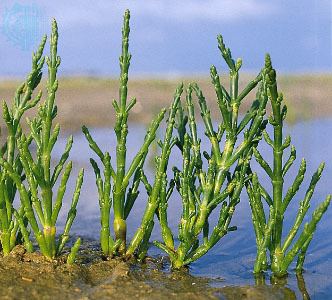
All stems are terminating in spike-like apparently jointed inflorescences. Each joint consists of two opposite minute bracts with an (1-) 3-flowered cyme tightly embedded in cavities of the main axis and partly hidden by the bracts. The flowers are arranged in a triangle, both lateral flowers beneath the central flower. The hermaphrodite flowers are more or less radially symmetric, with a perianth of three fleshy tepals connate nearly to the apex. There are 1-2 stamens and an ovary with two stigmas.
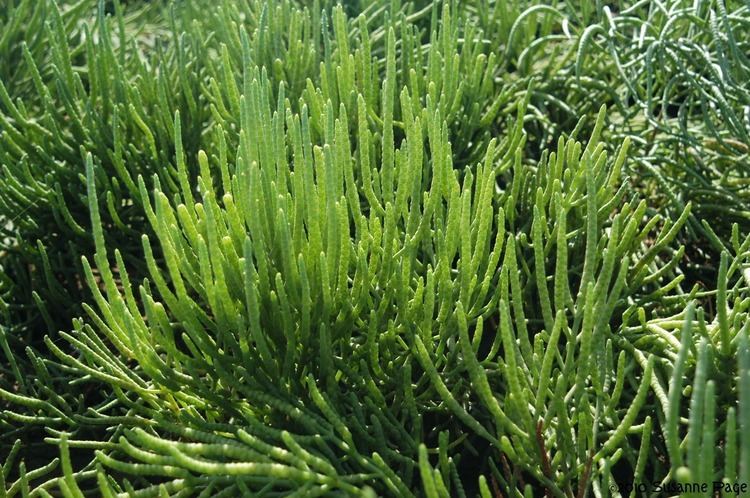
The perianth is persistent in fruit. The fruit wall (pericarp) is membranous. The vertical seed is ellipsoid, with yellowish brown, membranous, hairy seed coat. The seed contains no perisperm (feeding tissue).
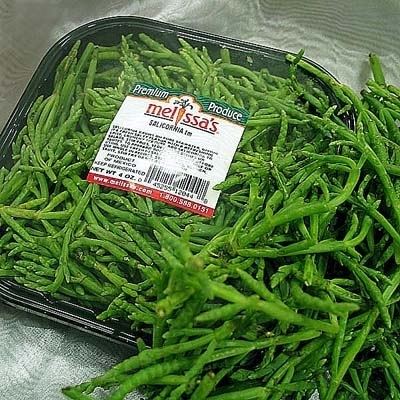
Like most members of the subfamily Salicornioideae, Salicornia species use the C3 carbon fixation pathway to take in carbon dioxide from the surrounding atmosphere.
Distribution and habitat
The species of Salicornia are widely distributed over the Northern Hemisphere and in southern Africa, ranging from the subtropics to subarctic regions. They are absent from South America and Australia.
They grow in coastal salt marshes and in inland salty habitats like shores of salt lakes. Salicornia species are halophytes and can generally tolerate immersion in salt water (hygrohalophytes).
Ecology
Salicornia species are used as food plants by the larvae of some Lepidoptera species, including the Coleophora case-bearers C. atriplicis and C. salicorniae (the latter feeds exclusively on Salicornia spp.).
Phylogenetics
The genus probably originated during the Miocene in the region between the Mediterranean basin and Central Asia. Evolving from within the perennial and frost-sensitive genus Sarcocornia, the annual, strongly inbreeding and frost-tolerant Salicornia diversified during the late Pliocene to early Pleistocene. By events of intercontinental dispersals, they reached southern Africa twice, North America at least three times. Two tetraploid lineages expanded rapidly, with the ability to colonize lower belts of the saltmarshes than their diploid relatives. Inbreeding and geographical isolation led to a large number of reproductive isolated species that are only weakly differentiated.
Systematics
The genus Salicornia was first described in 1753 by Carl Linnaeus. Salicornia europaea was selected as the type species.
The taxonomic classification of this genus is extremely difficult (and has been called a "taxonomic nightmare"), determination of species seems almost impossible for non-specialists. The reasons for those difficulties are the reduced habit with weak morphological differentiation, and high phenotypic variability. As the succulent plants lose their characteristics while drying, herbarium specimens often cannot be determined with certainty and are less suited for taxonomic studies.
Based on molecular genetic research (Kadereit et al. 2007, 2012), Salicornia comprises the following species:
In Eurasia:
In North America:
In Africa:
In South Asia:
Culinary
Salicornia europaea is edible, either cooked or raw. In England, it is one of several plants known as samphire (see also Rock samphire); the term samphire is believed to be a corruption of the French name, [herbe de] Saint-Pierre, which means "St. Peter's herb".
Samphire is usually cooked, either steamed or microwaved, and then coated in butter or olive oil. Due to its high salt content, it must be cooked without any salt added, in plenty of water. It has a hard, stringy core, and after cooking, the edible flesh is pulled off from the core. This flesh, after cooking, resembles seaweed in color, and the flavor and texture are like young spinach stems or asparagus. Samphire is often used as a suitably maritime accompaniment to fish or seafood.
In addition to S. europaea, the seeds of S. bigelovii yield an edible oil. S. bigelovii's edibility is compromised somewhat because it contains saponins, which are toxic under certain conditions.
Umari keerai is cooked and eaten or pickled. It is also used as fodder for cattle, sheep and goats. In Kalpitiya, Sri Lanka, it is used to feed donkeys.
On the east coast of Canada, the plant is known as "samphire greens" and is a local delicacy. In Southeast Alaska, it is known as "beach asparagus". In Nova Scotia, Canada, they are known as "crow's foot greens". In British Columbia, Canada, they are known as "Sea Asparagus". In the United States, they are known as "sea beans" when used for culinary purposes. Other names include "sea asparagus", "sea green bean", "pousse-pierre", "passe-pierre", "pousse-pied", "sea pickle", and "marsh samphire".
In India, researchers at the Central Salt and Marine Chemicals Research Institute developed a process to yield culinary salt from Salicornia brachiata. The resulting product is known as vegetable salt and sold under the brand name Saloni.
Historical
The ashes of glasswort and saltwort plants and of kelp were long used as a source of soda ash (mainly sodium carbonate) for glassmaking and soapmaking. The introduction of the LeBlanc process for industrial production of soda ash superseded the use of plant sources in the first half of the 19th century.
Umari keerai is used as raw material in paper and board factories.
Contemporary
Because Salicornia bigelovii can be grown using saltwater and its seeds contain high levels of unsaturated oil (30%, mostly linoleic acid) and protein (35%), it can be used to produce animal feedstuff and as a biofuel feedstock on coastal land where conventional crops cannot be grown. Adding nitrogen-based fertiliser to the seawater appears to increase the rate of growth and the eventual height of the plant, and the effluent from marine aquaculture (e.g. shrimp farming) is a suggested use for this purpose.
Experimental fields of Salicornia have been planted in Ras al-Zawr (Saudi Arabia), Eritrea (northeast Africa) and Sonora (northwest Mexico) aimed at the production of biodiesel. The company responsible for the Sonora trials (Global Seawater) claims between 225 and 250 gallons of BQ-9000 biodiesel can be produced per hectare (approximately 2.5 acres) of salicornia, and is promoting a $35 million scheme to create a 12,000-acre (49 km2) salicornia farm in Bahia de Kino. Stems and roots of Salicornia brachiata plants had high cellulose contents (ca. 30%), whereas tender stem tips contents low cellulose content (9.2%). Salicornia brachiata revealed the dominance of rhamnose, arabinose, mannose, galactose, and glucose, with meager presence of ribose and xylose in their structural polysaccharide.
Environmental uses
Pickleweed is used in Phytoextraction, it is highly effective at removing selenium from soil, which is absorbed by the plant and then released into the atmosphere to be dispersed by prevailing winds. Pickleweed (Salicornia bigelovii) has been found to have average volatilization rates 10-100 times higher than other species.
